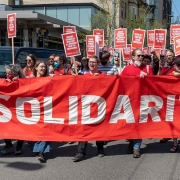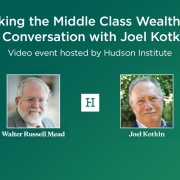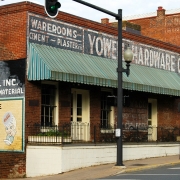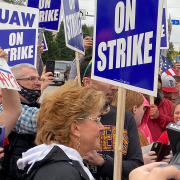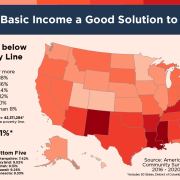The Collapse of the Progressive Economy
In recent decades, progressive politics has been underwritten by the ascendant economic titans of capital, technology, and communication. Big Tech and financial firms have long financed Democratic causes, led by those such as George Soros and the now-disgraced crypto-master Sam Bankman-Fried, who was released last month on a $250 million bail deal.
Yet for all its claims to represent the future, this ephemeral economy is starting to unravel, as the world begins to wake up to the fundamental realities underlying daily life. It turns out that, while they may seem old-fashioned in today’s digital world, material goods actually matter when they are hard to procure. Over the past year, traditional industries such as manufacturing, agriculture and energy have thrived, while media companies have lost $500 billion in value and tech firms have suffered a reversal of an astounding $4 trillion. Today, it’s not steel companies or gas plants that are experiencing mass layoffs, but firms such as Goldman Sachs, Meta, Amazon and Google.
Indeed, after its decade-long bender, the progressive economy is about to wake up to a massive hangover. And its minions are getting restless. Companies such as Amazon and Starbucks — like their industrial predecessors during the Depression — face increased union militancy, an uncomfortable reality for long-time virtue-signallers such as Starbucks’s Howard Schultz, who has long portrayed himself as an enlightened model aristocrat. Discontent is even brewing in the media, with the New York Times now experiencing labour unrest. Across the board, a bitter truth is slowly coming into focus: skilful public relations no longer can make up for widening class distinctions.
Equally unsettling has been the incessant labour unrest at America’s universities. Amid mounting declines in enrolment, these lordly institutions have been exposed as exploitative, favouring a tenured faculty with rich pensions but offering little to severely underpaid adjuncts and teaching assistants, who now constitute the vast majority of the academic workforce. These are the folk now staging walkouts. The professoriate may see themselves as enlightened tools of right-on thinking, but to many others they seem like Stalin’s much maligned Kulaks, rich peasants thriving on the work of the poor.
Even the preferred geographic heart of the progressive economy — big, dense, expensive cities — is clearly fading. Today, most of those places dominated by progressives face mounting financial pressures, which are leading activists to demand higher taxes on the rich. With high-tech start-ups and high-wage jobs stagnating, in California, for example, a $100 billion state surplus is now widely expected to turn into a $25 billion deficit next year. Ultra-blue New York, Illinois, and Massachusetts also face potentially large, and expanding, shortfalls.
As these progressive economies unravel, we are likely to see greater conflict between their two bulwarks: the Leftist activists and ultra-rich oligarchs who have embraced causes as a part of their identity. This profoundly contradictory romance could soon explode, as calls for an expanding and intrusive welfare state — the prime goal of the modern Left — becomes increasingly unpalatable for the wealthy. In flush years, these oligarchs could afford elaborate welfare and climate policies to flourish, even at their considerable expense. But increasingly, particularly since the pandemic, wealthy individuals are bailing to low-cost places such as Florida. Elsewhere, governors such as New York’s Kathy Hochul and California’s Gavin Newsom may express worries about new tax-the-rich schemes, but they will soon have to face off with determined, increasingly radical elements in the Democratic Party more interested in promoting class warfare and “climate justice” than sustaining the local economy.
Of course, the root of this conflict is bipartisan. The rapid decline of Trumpism, and its transformation into a kind of weird cult, has ripped off the adhesive that united the ultra-rich, the militant activists and the party machine. Silicon Valley still retains its close ties to Democrats but the big money is shifting somewhat towards the GOP. Even long-time progressive funders such as Nike’s Phil Knight have had enough, and put $1 million behind the Republican candidate for Governor in Oregon.
The pandemic has also played a critical role in this evolution, first boosting tech, real estate, and stock prices to historic highs — and then forcing interest rates to increase, as the pandemic eased and the cost of massive bailouts, supply chain issues and inflation became clear. Real estate prices, particularly in elite office districts, plummeted, while stocks lost their appeal. The market for digital products began to sag and, in the case of cryptocurrency, collapsed.
Crucially, inflation on food, energy and home prices hits traditional Democratic constituencies the hardest. It’s unsurprising that those most affected by shortages in the labour market are not graduates of Oberlin or other elite liberal colleges. Instead, the big demand, notes former California labour commissioner Michael Bernick, is for people who can drive a truck, construct a house, change beds, or perform nursing duties. Venture capitalist and AI entrepreneur Rony Abovitz suggests the future may be brighter for people who can install plumbing systems than those who perform tasks easily done by machine. “It’s the end of the white-collar knowledge work,” Abovitz told me. Instead, he predicts the coming years will be shaped more by the rise of the “sophisticated, technically capable blue-collar worker”.
Read the rest of this piece at UnHerd.
Joel Kotkin is the author of The Coming of Neo-Feudalism: A Warning to the Global Middle Class. He is the Roger Hobbs Presidential Fellow in Urban Futures at Chapman University and Executive Director for Urban Reform Institute. Learn more at joelkotkin.com and follow him on Twitter @joelkotkin.
Photo: Elliot Stoller via Flickr under CC 2.0 License.

